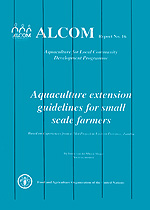 |
ALCOM GCP/INT/555/SWE
Aquaculture for Local Community Development Programme GCP/RAF/277/BEL
ALCOM Report No. 16
Aquaculture extension guidelines for small scale farmers:
Based on experiences from a pilot project in Eastern Province, Zambia
By Jennie van der Mheen-Sluijer
Socio-economist
Funding Agencies:
SWEDISH INTERNATIONAL DEVELOPMENT AUTHORITY
BELGIAN ADMINISTRATION FOR DEVELOPMENT CO-OPERATION
Executing Agency:
FOOD AND AGRICULTURE ORGANIZATION OF THE UNITED NATIONS
Harare, Zimbabwe, April 1995
|
| The designations employed and the presentation of the material in
this publication do not imply the expression of any opinion
whatsoever on the part of the Food and Agriculture Organization of
the United Nations concerning the legal status of any country,
territory, city or area or of its authorities, or concerning the
delimitation of its frontiers or boundaries. |
PREFACE
SUMMARY
1. INTRODUCTION
2. EXTENSION APPROACH
2.1 Target Group Identification
2.2 Participation of Target Groups
3. SITUATION ANALYSIS
3.1 Situation Analysis for Project Formulation
3.2 Situation Analysis for Project Planning
3.3 Situation Analysis for Project Monitoring
3.4 Methods of Collecting Information
4. EXTENSION MESSAGE
5. EXTENSION METHODS
5.1 Communication between Extension Workers and Target Group Members
5.2 Combination of Extension Methods Used in the Pilot Project
6. EXTENSION MATERIAL
6.1 The Slide Show
6.1.1 Features of the Slide Show
6.1.2 How to Produce a Slide Show
6.1.3 How to Test the Effectiveness of a Slide Show
6.2 Illustrated Pamphlets
6.2.1 Features of the Illustrated Pamphlets
6.2.2 How to Produce Illustrated Pamphlets
6.2.3 How to Test the Effectiveness of Illustrated Pamphlets
7. TRAINING OF EXTENSION OFFICERS
7.1 On-the-Job Training
7.2 Formal Training
8. MONITORING AND EVALUATION
8.1 Target Group Attainment
8.2 Participation of Target Group
8.3 Rise in Living Standard of Target Group
8.4 Communication with Target Group
8.5 Performance of Extensionists
REFERENCES
APPENDIX 1: Checklist for information collection in the situation analysis
APPENDIX 2: Examples of the different versions of the pamphlet
APPENDIX 3: Examples of instructions for artist
LIST OF TABLES
Table
1. Factors Influencing Participation and Possible Solutions
2. Socio-cultural, Socio-economic, Bio-environmental and Bio-technical aspects of Rural Aquaculture
3. Main Findings of Situation Analysis in Eastern Province, Zambia, for Project Planning
4. Identification of Locally Available Resources for Compost or Fish Feed
5. Targets, Obstacles and Measures to Render Fish Farming an Activity within the Reach of Small-Scale Rural Farmers
6. Main Findings of Studies Carried out During the Implementation Phase
7. Fish Farming System Suitable for Small-Scale Farmers in Eastern Province, Zambia
8. Advantages and Disadvantages of Extension Methods Available to the Project
9. Combination of Communication Channels Used by the Project to Reach Small-Scale Farmers
10. Subject for Review: Target Group Attainment
11. Household Characteristics per Wealth Stratum
12. Subject for Review: Participation of Target Group in All Stages
13. Decision Making Pattern for Fish Farming
14. Subject for Review: Rise in Living Standards of Target Group
15. Effective Means of Communication between Fish Farming Technicians/Extensionists and Community Members
16. Subject for Review: Training of Extensionists to use the Methodology
17. Actual and Desired Characteristics of Motivators
LIST OF FIGURES
Figure
1. Differentiation of Groups in Pilot Areas
2. Drawing of Compost Crib made by Artist
3. Diagram of Study Design on Effectiveness Slide Show
4. Drawing of a Woman Feeding Fish
5. Diffusion of Fish Farming in Eastern Province
6. Inputs and Outputs for a Typical Production Cycle
7. Source of Fish Farming Advice
How to Order
